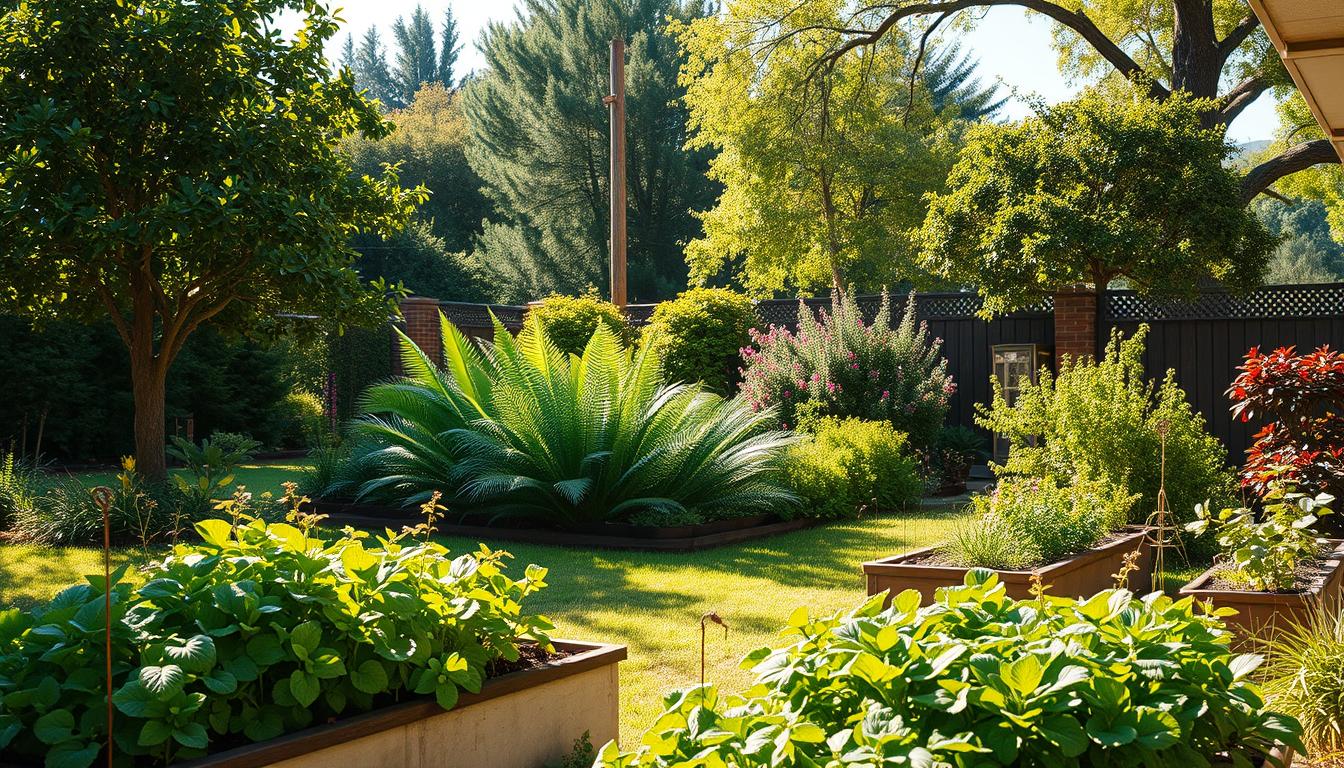Have you ever noticed how some spots in your yard grow plants better than others? It’s not just luck. It’s the magic of natural microclimates at work. By using these unique spots, you can greatly improve your gardening.
Microclimate gardening uses special areas where the weather is different. These spots have their own temperature, moisture, and sunlight. This lets you grow plants that might not do well in your area’s climate. Imagine growing ripe tomatoes early or having tropical plants thrive in northern states!
Learning about these small climate differences can turn your yard into a productive oasis. You’ll learn to extend your growing season, reduce plant stress, and find the perfect spots for hard-to-grow plants.
In this guide, we’ll show you how to find, improve, and create beneficial growing spots in your yard. Whether you have a big yard or a small balcony, these tips will help you use every inch. Get ready to see your outdoor space in a new light and unlock its full potential!
The Hidden Potential of Garden Microclimates
Every garden, no matter how small, has many microclimates waiting to be used. These special spots have their own growing conditions. They are hidden gems that many gardeners miss.
Microclimates are like secret zones in your garden. They have their own temperature, moisture, and soil conditions. These small differences can make a big difference in how well plants grow.
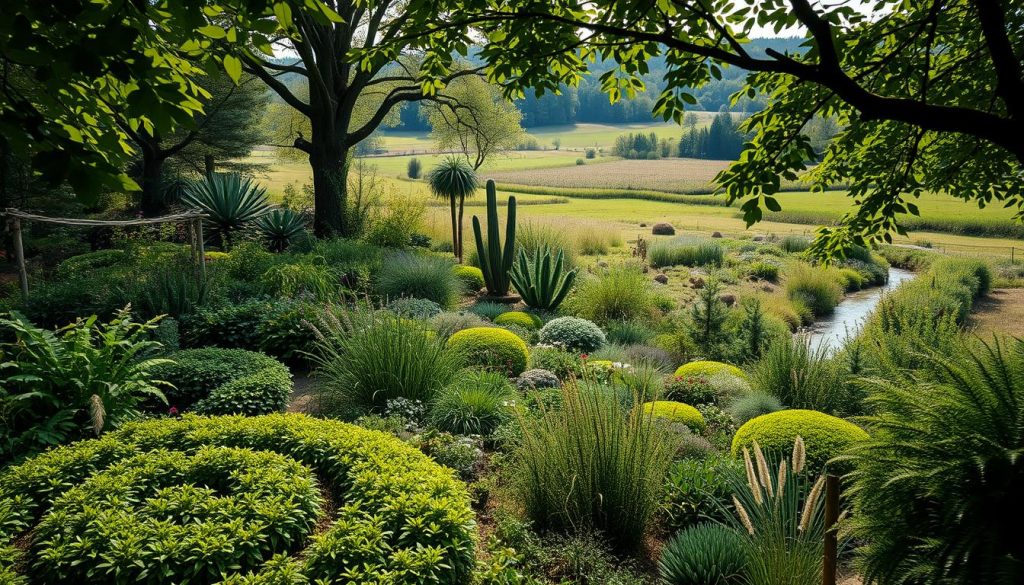
What Defines a Microclimate in Your Yard
A microclimate is a small area with its own climate. In your yard, these can be created by many things. For example, a south-facing wall can get hot during the day and warm at night.
Things like fences and trees can block wind and create shelter. Trees also cast shade that changes with the seasons. Even things like patios and driveways can affect how warm or cool an area is.
These factors mix together to create different growing conditions across your yard. A spot just a few feet away can be very different. This is because of changes in sun, wind, and soil moisture.
Why Understanding Microclimates Revolutionizes Gardening
Knowing about microclimates is like having special tools for your garden. It helps you choose the right spot for each plant. This way, plants get what they need without you having to do much.
When you match plants with their natural environment, they need less care. Plants that like dry soil or shade will do better in those spots. This makes your garden easier to take care of and more successful.
One of the coolest things is growing plants that are hard to grow in your area. A spot with morning sun might be perfect for a warmer-weather plant. A sheltered area near your house could protect a tender plant through winter.
By using microclimates, you can grow more in your garden without making it bigger. It’s a way to get the most out of your space.
The Science of Microclimate Gardening
Learning about microclimates opens up new possibilities in gardening. These small climate areas exist in every landscape. They offer conditions different from the rest of the area.
By recognizing these patterns, you can grow plants that might not do well in your region. This is because microclimates are based on science. They involve heat transfer, air movement, and moisture.
These factors create unique growing spots. Smart gardeners can use these spots for better results. Let’s look at how these mini-ecosystems work in your garden.
How Natural Microclimates Form in Landscapes
Several factors create natural microclimates. Topography, or the shape of the land, is key. South-facing slopes get more sun and warmth than north-facing ones.
Water bodies like ponds and streams also play a role. They absorb heat during the day and release it at night. This creates zones where plants might survive a frost.
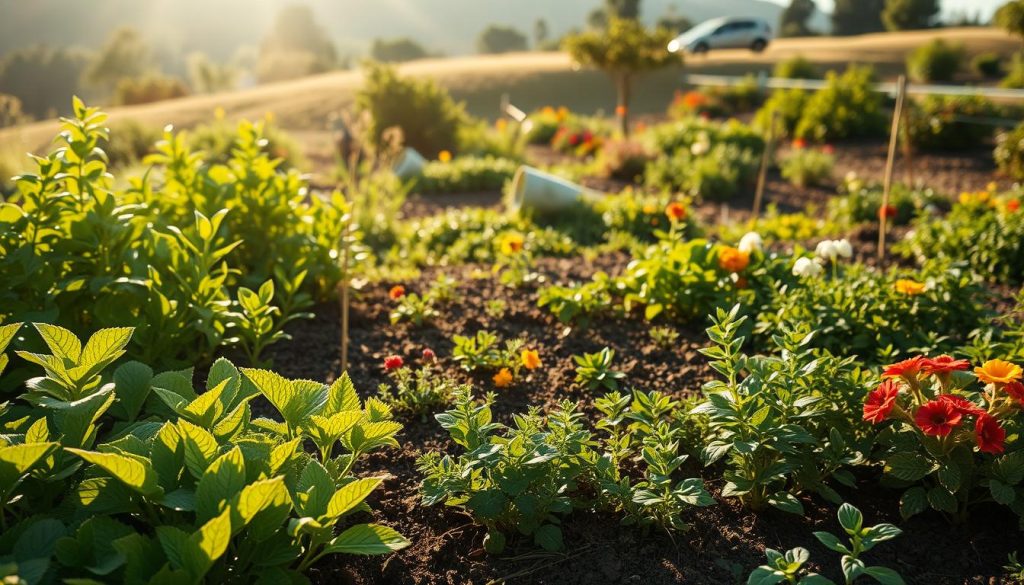
Structures like walls and paths affect microclimates too. They absorb and then release heat, making areas warmer. Buildings cast shadows that cool areas and block winds, helping plants grow.
Vegetation also shapes microclimates. Trees create shade patterns that change with the seasons. Dense shrubs block wind and trap moisture, creating different growing conditions.
Distinguishing Between USDA Zones and Your Yard’s Microzones
USDA zones help with plant selection, but they’re broad. They’re based on average temperatures and don’t show variations within properties.
Your yard likely has many microzones. Some might be warmer or cooler than your zone. A sheltered corner might be warmer, while a low area might be colder.
Knowing these differences helps with planting. Plants that seem out of your zone might do well in certain spots. Plants that should grow well might struggle in tough microclimates.
| Feature | USDA Hardiness Zones | Garden Microzones | Gardening Impact |
|---|---|---|---|
| Geographic Scale | Regional (covers thousands of square miles) | Hyperlocal (varies within feet) | Microzones allow for precise plant placement |
| Temperature Basis | Average annual minimum temperature | Daily temperature fluctuations | Microzones capture temperature nuances zones miss |
| Factors Considered | Primarily temperature | Temperature, wind, moisture, soil, shade | Microzones account for multiple growing factors |
| Adaptability | Static, changes only with climate shifts | Can be modified by gardener interventions | Microzones can be enhanced or created intentionally |
By understanding your property’s microclimates, you can place plants where they’ll thrive. This approach turns gardening into a strategic game. You work with nature’s patterns instead of against them.
Mapping the Microclimates in Your Garden
Discovering your garden’s microclimates can greatly improve your gardening. You don’t need fancy tools or special knowledge. Just observe and document. A microclimate map helps you place plants where they’ll do best, extend growing seasons, and grow varieties not suited to your area.
Tracking Sun Exposure Patterns Throughout Seasons
Sun exposure is key to your garden’s microclimates. Observe your garden at different times and seasons. Divide your day into morning, midday, and afternoon. Note which areas get full sun, partial sun, or shade.
Use colored pencils to shade your property map. Yellow for full sun, orange for partial, and blue for shade. Take photos from the same spots at different times to document these patterns.
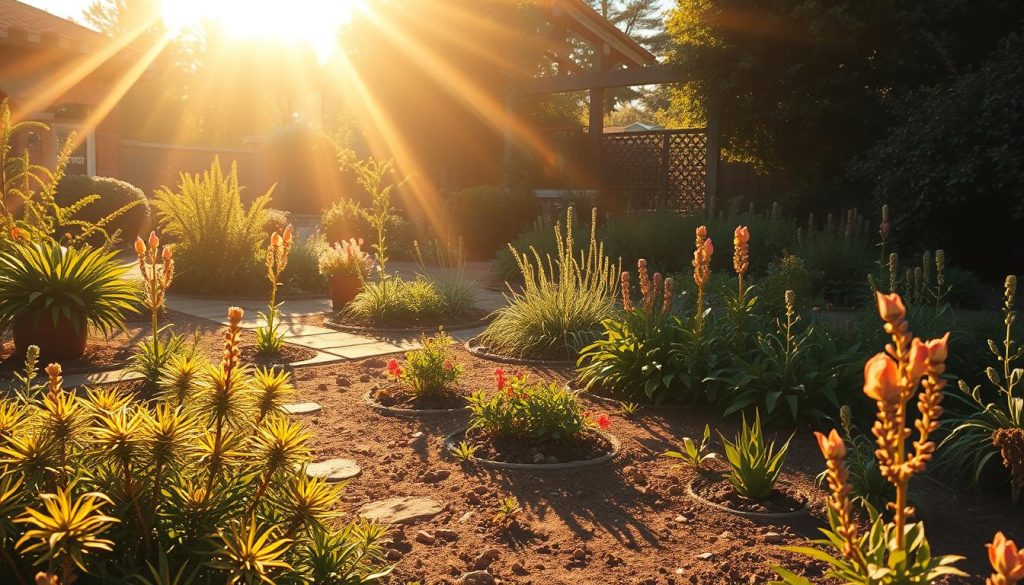
Morning and afternoon sun create different microclimates. Morning sun is gentle, perfect for plants that can’t handle afternoon heat. Afternoon sun is hotter, creating hot spots against walls.
Many plants love morning sun, while tomatoes and peppers prefer afternoon. Note these on your map to match plants with their best conditions.
Seasonal Sun Path Changes
The sun’s path changes with the seasons, affecting your garden. Areas that get full sun in summer may be shaded in winter. This is crucial for planning spring and fall crops or perennial placement.
Mark your calendar for solstices and equinoxes to update your sun map. This shows how shadows move, revealing season-specific growing spots.
Identifying Natural Shade Areas and Their Benefits
Shade areas in your garden are not a limitation. They offer unique growing opportunities. Shade can be light, partial, or full, each with its own benefits.
Shade retains moisture, protects from heat, and supports shade-loving plants. It extends the harvest season for cool-season crops. It’s also great for plants like ferns and hostas that can’t handle direct sun.
The north sides of buildings and under deciduous trees are excellent for shade. They change with the seasons, offering versatile growing spaces.
Analyzing Wind Corridors and Protected Spots
Wind patterns are crucial but often overlooked. Strong winds dry out plants, damage them, and make areas colder. Observe your garden on breezy days to note where leaves rustle more.
Look for natural wind corridors and spaces that funnel air. These may need windbreaks to protect crops. Also, find sheltered spots that warm up faster in spring and stay warmer in fall.
Mark these spots on your map for early spring plantings or tender perennials. They can extend your growing season by weeks.
Temperature Microzones: Your Garden’s Hidden Growing Opportunities
Your garden has secret spots where plants can grow better than you think. These spots, just a few feet apart, have different temperatures. By finding these areas, you can grow plants that usually don’t do well in your area.
This means you can grow plants longer and in different climates. It’s like having a superpower for your garden.
Heat-Trapping Features: Walls, Rocks, and Hardscapes
Things like walls and rocks in your garden keep heat in at night. A south-facing stone wall can make a spot warm like the Mediterranean. This can make it 5-15°F warmer than other areas.
Dark rocks and pavers get hot in the sun. They can warm the soil around them. This is great for plants like tomatoes and peppers.
Even a simple brick path can keep plants warm. It’s like a tiny shield against cold.
Concrete areas get hot too. They can make a small “heat island.” Use this heat for plants that like it warm. Plants in containers near warm walls do well too.
| Heat-Trapping Feature | Temperature Increase | Best Placement | Ideal Plants |
|---|---|---|---|
| Stone Wall (South-facing) | 8-15°F warmer | Northern garden boundary | Mediterranean herbs, tender perennials |
| Dark Rock Mulch | 5-10°F warmer | Around heat-loving plants | Tomatoes, peppers, eggplants |
| Concrete Patio | 6-12°F warmer | Adjacent to structure | Citrus trees, tropical plants |
| Brick Pathway | 3-8°F warmer | Garden center or borders | Tender annuals, early vegetables |
Identifying and Managing Frost Pockets
Some parts of your garden get cold, creating frost pockets. These cold spots can damage plants. They form in low areas where cold air settles.
To find frost pockets, watch your garden after the first frost. Look for areas where frost stays longest. These spots are colder than others.
Instead of fighting cold spots, choose plants that like it cool. Alpine plants and early bloomers do well here. You can also raise beds or use windbreaks to help.
Using Temperature Variations to Grow Beyond Your Zone
Once you know your garden’s temperature spots, place plants wisely. That plant that’s one zone warmer? It might do great in your garden’s warm spots.
In cold areas, use sunny spots for plants like figs and roses. In hot places, use shady spots for plants that can’t handle the heat.
Start small with one plant in a good spot. Take notes and add more plants as you learn. Many gardeners grow plants two zones away by matching plants to their garden’s spots.
Soil Conditions That Create Distinct Microclimates
Your garden’s soil is like a secret architect, shaping microclimates for different plants. We often focus on sunlight and wind, but the soil beneath is key. Knowing how soil shapes these microclimates helps you choose the right plants for each spot.
Soil affects moisture and root temperature, making some areas better for plants than others. By understanding your soil, you can find hidden spots in your garden to grow plants.
Regional Soil Types and Their Microclimate Effects
The soil in your area is the base of your garden. Different soils like sandy, clay, loam, and silt create unique growing spots. Sandy soils dry fast but warm up quickly, good for plants that like dry conditions.
Clay soils hold moisture longer and warm slower, perfect for plants that need steady water. Loamy soils balance moisture and drainage, supporting a wide variety of plants. Your soil’s natural pH also affects which plants grow well without extra nutrients.
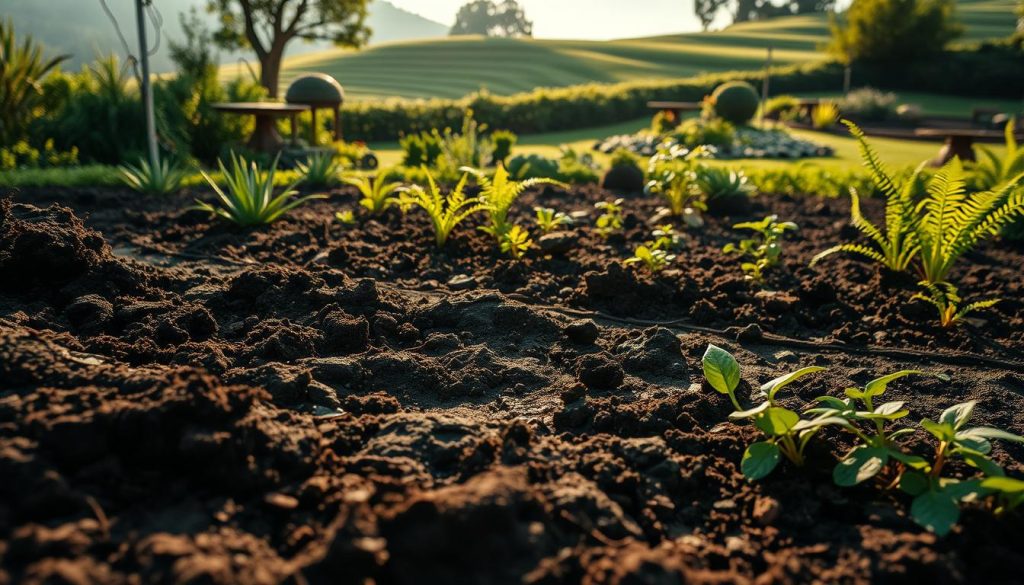
Even on the same property, different soil types can exist. A low spot might collect clay, while a raised bed could be sandy. These differences create a variety of growing conditions for gardeners to use.
| Soil Type | Moisture Retention | Warming Speed | Microclimate Effect | Ideal Plants |
|---|---|---|---|---|
| Sandy | Low | Fast | Warm, dry conditions | Lavender, rosemary, cacti |
| Clay | High | Slow | Cool, moist conditions | Asters, hostas, ferns |
| Loam | Medium | Moderate | Balanced conditions | Most garden vegetables |
| Silt | Medium-High | Moderate | Fertile, slightly moist | Willows, dogwoods, sedges |
Water Movement and Drainage Patterns
Water moves differently across your landscape. The shape of your property guides water flow, creating wet and dry spots. Low areas collect water, making them great for plants that love moisture.
High spots, on the other hand, shed water quickly, making them better for plants that don’t like wet feet. Soil type greatly affects how water moves. Clay soils stay wet longer, while sandy soils dry out fast.
Features like tree roots and buried rocks can also change water flow. By watching where water pools and where it dries, you can plan your garden better.
How Soil Temperature Varies Across Your Property
Soil temperature can change a lot in your garden, affecting plant growth. Dark soils warm up faster than light ones, helping warm-season crops grow sooner. This can give you a head start on the growing season.
Soil rich in compost keeps temperatures steady, protecting roots from extreme changes. These areas are great for sensitive plants.
Soil temperature also changes with sun and shade. South-facing slopes can be warmer than north-facing ones with the same soil. By checking soil temperature, you can find the best spots for heat-loving and cool-loving plants.
Humidity and Moisture Levels in Garden Microclimates
Temperature gets a lot of attention, but humidity is just as important. It affects how plants breathe and their risk of disease. Knowing about moisture levels helps you choose the right plants or adjust your garden for them.
Natural Humidity Variations Within Your Landscape
Every garden has different humidity zones. These can change a lot in just a few feet. Low spots collect cool, moist air, making them great for plants that love moisture.
Being near water, like a birdbath, makes the air more humid. Dense plants also keep moisture in by releasing water vapor. This helps plants stay in the humid conditions they prefer.
You can spot humidity differences by looking at:
- Morning dew patterns (where dew stays longest is more humid)
- Moss growth (shows consistently moist spots)
- Plant stress signs (plants wilt in dry spots, get fungal issues in humid ones)
- Air movement (dry areas are breezy)
These natural changes let you grow plants with different moisture needs without big changes to your garden.
Creating Moisture-Rich Zones with Water Features
Water features help make humid spots for plants that love moisture. They also make your garden look good and attract wildlife.
Ponds make humid spots near their edges. The water’s evaporation raises humidity by 20-30%. Place moisture-loving plants like astilbe and ferns nearby but make sure the soil drains well to avoid root rot.
Rain Gardens and Swales
Rain gardens catch roof and hard surface runoff, making spots moist. These areas, filled with plants that like water, are humid when it’s wet and dry when it’s dry. Swales, shallow channels, spread this effect, making dry areas more humid.
Drought-Resistant Microclimates for Xeric Plants
Dry spots in your garden are just as valuable. South-facing slopes, areas under roof overhangs, and spots near reflective surfaces are drier. These are perfect for plants that don’t like wet conditions.
To make these areas better for dry plants, you can:
- Add gravel mulch to reflect heat and reduce moisture
- Build raised beds for better drainage
- Group plants that like dry conditions together
Plants like lavender and Russian sage do well in these dry spots. By using these areas, you can create beautiful, easy-to-care-for gardens that show off xeric plants.
Designing and Modifying Your Garden’s Microclimates
By designing your garden with microclimates in mind, you can grow more plants. You can change your garden to fit the needs of your favorite plants. Even tough spots can become great places to grow things.
Strategic Hardscaping to Create Ideal Growing Conditions
Hardscaping is more than just making your garden look good. It helps control the climate in your garden. Stone, brick, concrete, and wood can trap heat, block wind, and change moisture levels.
Choosing the right materials is key. Dark colors absorb heat, while light colors reflect it. Gravel lets water drain fast, making areas drier. Solid surfaces can make areas wetter.
Walls and Raised Beds as Microclimate Tools
Walls and raised beds are very useful in your garden. A south-facing stone wall gets hot in the day and warm at night. This is great for plants that love heat.
Raised beds warm up faster in spring. This lets you plant earlier in cold places. They also drain water well and can have special soil for plants.
Pathways and Patios as Heat Sinks
Pathways and patios soak up heat during the day and release it at night. This helps protect plants from extreme temperatures. Here are some ways to use them:
- Put frost-sensitive plants near stone or brick patios for warmth
- Use dark-colored pavers in shady spots to warm them up
- Gravel paths in wet areas improve drainage
- Concrete paths can reflect light onto plants in shady spots
Windbreaks and Shelter Belts for Climate Control
Knowing your wind patterns is important for garden design. Strong winds can harm plants, make them lose water, and make areas colder. A good windbreak can make a tough spot into a cozy garden.
Windbreaks don’t block all wind. They let 50-60% of air through, reducing wind speed. This creates a safe area about 5 times the height of the windbreak downwind.
For big areas, plant mixed shelter belts with trees. In small gardens, use fencing, trellises, or big containers to block wind. Place these barriers across the wind for best results.
Seasonal Structures to Extend Growing Seasons
Seasonal structures can make your garden warmer and longer. Cold frames, cloches, and hoop houses keep plants warm and safe from bad weather. This lets you start planting earlier and keep growing later.
Simple DIY projects include using plastic milk jugs or clear plastic over PVC hoops. For more lasting solutions, think about a greenhouse or cold frames from recycled windows.
These structures work best when they get lots of sun in cool months. Make sure to open them on warm days to avoid too much heat. With these tools, you can grow plants in cooler places and enjoy fresh food longer than usual.
Plant Selection Strategies for Different Microclimates
Choosing the right plants for your garden’s microclimates can greatly improve your success. After identifying and mapping your yard’s microclimates, you can pick the best plants for each area. This approach opens up new possibilities for your garden.
Matching Plant Requirements to Existing Microclimates
Understanding what each plant needs is key to successful gardening. Plants have specific needs for light, moisture, temperature, and wind. When you match these needs to the right spot, your plants will thrive.
Start by reading plant tags and researching their native growing conditions. Check if a plant likes full sun, partial shade, or full shade. Also, consider its water needs, temperature tolerances, and wind sensitivity. Then, find the perfect spot in your garden for it.
For example, put moisture-loving ferns and hostas in damp, shady spots. Use the hot, dry area against a south-facing wall for Mediterranean herbs like rosemary and lavender. The area near your home’s foundation is great for plants that need wind protection.
This targeted approach saves you time and effort. Plants in their natural conditions grow stronger, resist disease better, and produce more. Your garden will take care of itself, and you’ll enjoy it more.
Growing “Impossible” Plants in Carefully Created Microzones
Microclimate gardening lets you grow plants that seem impossible in your area. By creating special microzones, you can grow plants beyond your zone.
Gardeners everywhere have grown plants that defy regional guides. In Minnesota, some grow Zone 5 figs against warm brick walls. In the Pacific Northwest, gardeners create dry spots for desert plants despite the rain.
The secret is to understand what challenges a plant faces in your area. Then, create a microclimate that solves those problems. This might involve changing the temperature, moisture, or wind conditions.
| Plant Type | Challenging Climate Factor | Microclimate Solution | Success Tips |
|---|---|---|---|
| Citrus Trees | Cold winters | South-facing wall with overhead protection | Add thermal mass (rocks, water barrels) to store heat |
| Alpine Plants | Summer heat and humidity | Elevated rock garden with sharp drainage | Morning sun only; use light-colored rocks to reflect heat |
| Tropical Perennials | Cold temperatures | Protected courtyard or near home foundation | Mulch heavily; consider temporary winter protection |
| Desert Succulents | Excess moisture | Raised bed with sandy, gravelly soil | Create rain shadow using structures or larger plants |
Remember, growing plants at the edge of their hardiness needs patience and adaptation. Start small and observe what works in your garden. Take notes to improve your gardening skills.
Learning about microclimates helps you know where each plant belongs. This skill lets you create a diverse, resilient garden that reflects your style and works with nature.
Transforming Your Garden Through Microclimate Awareness
Looking at your garden through the lens of microclimates changes everything. Instead of battling nature, you begin partnering with it. This shift in perspective turns challenging spots into opportunities and problem areas into perfect planting zones.
By mapping and working with your garden’s microclimates, you’ll notice plants thriving with less effort. They experience reduced stress when placed in ideal conditions, leading to fewer diseases and stronger growth. Your water bills may drop as plants in suitable microclimates need less supplemental irrigation.
The magic of microclimate gardening appears when you successfully grow plants that shouldn’t survive in your region. That tender herb or flowering shrub labeled “one zone warmer” can flourish against a south-facing wall. The shade-loving woodland plant might thrive in that spot you once considered useless.
Start your microclimate journey with simple observation. Spend a weekend tracking sun patterns across your yard. Note where snow melts first in spring or where frost appears earliest in fall. Feel the natural wind tunnels that form between structures. These observations build your microclimate awareness over time.
Try an experiment with just one challenging plant placed in a protected microzone. Watch how it responds and adjust as needed. Each season brings new insights about your garden’s unique microclimates.
As your understanding deepens, your entire relationship with gardening transforms. You’ll work more efficiently, grow more successfully, and connect more deeply with your outdoor space. Your garden becomes not just a collection of plants but a tapestry of microclimates woven together into a thriving ecosystem that reflects your growing wisdom.

